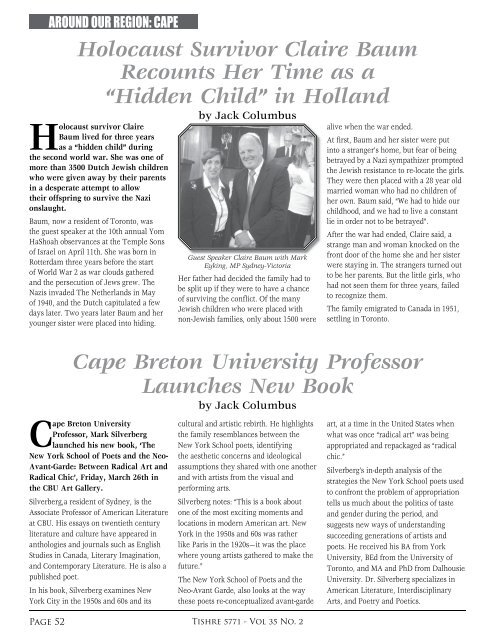Shalom magazine - The Atlantic Jewish Council
Shalom magazine - The Atlantic Jewish Council
Shalom magazine - The Atlantic Jewish Council
You also want an ePaper? Increase the reach of your titles
YUMPU automatically turns print PDFs into web optimized ePapers that Google loves.
arouNd our regioN: Cape<br />
Holocaust Survivor Claire Baum<br />
Recounts Her Time as a<br />
“Hidden Child” in Holland<br />
Holocaust survivor Claire<br />
Baum lived for three years<br />
as a “hidden child” during<br />
the second world war. She was one of<br />
more than 3500 Dutch <strong>Jewish</strong> children<br />
who were given away by their parents<br />
in a desperate attempt to allow<br />
their offspring to survive the Nazi<br />
onslaught.<br />
Baum, now a resident of Toronto, was<br />
the guest speaker at the 10th annual Yom<br />
HaShoah observances at the Temple Sons<br />
of Israel on April 11th. She was born in<br />
Rotterdam three years before the start<br />
of World War 2 as war clouds gathered<br />
and the persecution of Jews grew. <strong>The</strong><br />
Nazis invaded <strong>The</strong> Netherlands in May<br />
of 1940, and the Dutch capitulated a few<br />
days later. Two years later Baum and her<br />
younger sister were placed into hiding.<br />
by Jack Columbus<br />
Guest Speaker Claire Baum with Mark<br />
Eyking, MP Sydney-Victoria<br />
Her father had decided the family had to<br />
be split up if they were to have a chance<br />
of surviving the conflict. Of the many<br />
<strong>Jewish</strong> children who were placed with<br />
non-<strong>Jewish</strong> families, only about 1500 were<br />
Page 52 Tishre 5771 - Vol 35 No. 2<br />
alive when the war ended.<br />
At first, Baum and her sister were put<br />
into a stranger’s home, but fear of being<br />
betrayed by a Nazi sympathizer prompted<br />
the <strong>Jewish</strong> resistance to re-locate the girls.<br />
<strong>The</strong>y were then placed with a 28 year old<br />
married woman who had no children of<br />
her own. Baum said, “We had to hide our<br />
childhood, and we had to live a constant<br />
lie in order not to be betrayed”.<br />
After the war had ended, Claire said, a<br />
strange man and woman knocked on the<br />
front door of the home she and her sister<br />
were staying in. <strong>The</strong> strangers turned out<br />
to be her parents. But the little girls, who<br />
had not seen them for three years, failed<br />
to recognize them.<br />
<strong>The</strong> family emigrated to Canada in 1951,<br />
settling in Toronto.<br />
Cape Breton University Professor<br />
Launches New Book<br />
by Jack Columbus<br />
Cape Breton University<br />
Professor, Mark Silverberg<br />
launched his new book, ‘<strong>The</strong><br />
New York School of Poets and the Neo-<br />
Avant-Garde: Between Radical Art and<br />
Radical Chic’, Friday, March 26th in<br />
the CBU Art Gallery.<br />
Silverberg,a resident of Sydney, is the<br />
Associate Professor of American Literature<br />
at CBU. His essays on twentieth century<br />
literature and culture have appeared in<br />
anthologies and journals such as English<br />
Studies in Canada, Literary Imagination,<br />
and Contemporary Literature. He is also a<br />
published poet.<br />
In his book, Silverberg examines New<br />
York City in the 1950s and 60s and its<br />
cultural and artistic rebirth. He highlights<br />
the family resemblances between the<br />
New York School poets, identifying<br />
the aesthetic concerns and ideological<br />
assumptions they shared with one another<br />
and with artists from the visual and<br />
performing arts.<br />
Silverberg notes: “This is a book about<br />
one of the most exciting moments and<br />
locations in modern American art. New<br />
York in the 1950s and 60s was rather<br />
like Paris in the 1920s—it was the place<br />
where young artists gathered to make the<br />
future.”<br />
<strong>The</strong> New York School of Poets and the<br />
Neo-Avant Garde, also looks at the way<br />
these poets re-conceptualized avant-garde<br />
art, at a time in the United States when<br />
what was once “radical art” was being<br />
appropriated and repackaged as “radical<br />
chic.”<br />
Silverberg’s in-depth analysis of the<br />
strategies the New York School poets used<br />
to confront the problem of appropriation<br />
tells us much about the politics of taste<br />
and gender during the period, and<br />
suggests new ways of understanding<br />
succeeding generations of artists and<br />
poets. He received his BA from York<br />
University, BEd from the University of<br />
Toronto, and MA and PhD from Dalhousie<br />
University. Dr. Silverberg specializes in<br />
American Literature, Interdisciplinary<br />
Arts, and Poetry and Poetics.


